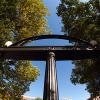UGA Announces Further Study of Baldwin Hall Remains
Photo Credit: Joshua L. Jones/file
UGA President Jere Morehead speaks at a ceremony in April, when the university reburied the remains found underneath Baldwin Hall in Oconee Hill Cemetery.
The University of Georgia will conduct further DNA analysis on the remains of former slaves found during a Baldwin Hall construction project in 2015, and try to reconstruct how the campus grew around the Old Athens Cemetery on campus.
A first round of studies by UGA anthropology professor Laurie Reitsema only examined mitochondrial DNA, which is easier to obtain but only contains information from female ancestors. In the second round, Reitsema will team up with University of Texas researchers who specialize in ancient remains to analyze nuclear DNA, which will yield information about the paternal side, and could allow Athens residents to find out if they are descended from anyone whose remains were exhumed.
About 105 people were buried underneath a parking lot that was dug up to make way for an expansion of Baldwin Hall. Of those, the remains of about 30 were intact enough to study. They were found to be mostly of African ancestry and likely slaves, given when they died. The remains were reinterred at nearby Oconee Hill Cemetery on the advice of the state archeologist, although many local African Americans wanted them reburied at a historically black cemetery like Brooklyn or Gospel Pilgrim.
In addition, Marguerite Madden, director of UGA’s Center for Geospatial Research, "will lead a team to create a dynamic time-series visualization of the cultural and natural landscape surrounding Baldwin Hall from the 1800s to the present," incorporating maps, aerial photographs, drone video and satellite images, the university said in a news release. The project will reveal more about the environment in which the people buried at Old Athens Cemetery lived and worked, and document the evolution of the cemetery and the campus.
Southeastern Archeological Services will be conducting archival research and using ground-penetrating radar to determine the boundaries of Old Athens Cemetery, also known as Jackson Street Cemetery. According to Reitsema, it may be much larger than previously believed, stretching from Broad Street to Baldwin Street. The cemetery was officially in use from the late 1700s until the Civil War, although burials likely continued through the 1890s.












comments